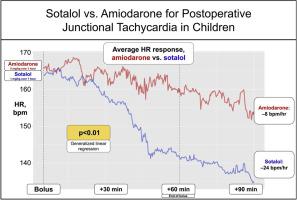Heart Rhythm ( IF 5.6 ) Pub Date : 2021-11-18 , DOI: 10.1016/j.hrthm.2021.11.021 Ellis Rochelson 1 , Santiago O Valdés 1 , Vicken Asadourian 2 , Raajen Patel 2 , Katherine Lemming 1 , Taylor S Howard 1 , Tam Dan N Pham 1 , Christina Y Miyake 1 , Jeffrey J Kim 1

|
Background
Junctional ectopic tachycardia (JET) is a common arrhythmia after congenital heart disease surgery. There is variability in the choice of antiarrhythmic therapy, with amiodarone used commonly. Intravenous (IV) sotalol is a newly available agent that may be useful for JET.
Objective
The purpose of this study was to evaluate the safety and efficacy of IV sotalol for postoperative JET and compare outcomes with IV amiodarone.
Methods
This is a retrospective single-center study of all patients who received IV sotalol or IV amiodarone for postoperative JET at Texas Children’s Hospital from December 15, 2015, to December 15, 2020. Data included antiarrhythmic efficacy, hemodynamics, and adverse effects. Successful JET control was defined as a decrease in JET rate to <170 beats/min (or decrease by >20%), or conversion to sinus rhythm, with persistent control over 24 hours without requiring alternative antiarrhythmics or mechanical support.
Results
A total of 32 patients (median age 71 days; interquartile range 17–221 days) received IV amiodarone (n = 20 [62%]) or IV sotalol (n = 12 [38%]) for postoperative JET. Amiodarone was successful in treating JET in 75% of cases; sotalol was successful in 83%. The JET rate decreased faster over the first 90 minutes after a sotalol bolus (25 beats/min per hour) than after an amiodarone bolus (8 beats/min per hour) (P < .01); no heart rate difference was seen after 24 hours. Amiodarone infusion was discontinued early because of hypotension/bradycardia in 2 patients; this was not required in any patients receiving sotalol.
Conclusion
For children with postoperative JET, both IV sotalol and amiodarone are safe and efficacious. IV sotalol may lead to a faster improvement in heart rate.
中文翻译:

索他洛尔与胺碘酮治疗先天性心脏病术后交界性心动过速
背景
交界性异位心动过速(JET)是先天性心脏病手术后常见的心律失常。抗心律失常治疗的选择存在差异,通常使用胺碘酮。静脉内 (IV) 索他洛尔是一种新的可用药物,可能对 JET 有用。
客观的
本研究的目的是评估静脉索他洛尔用于术后 JET 的安全性和有效性,并与静脉注射胺碘酮进行比较。
方法
这是一项回顾性单中心研究,对象为 2015 年 12 月 15 日至 2020 年 12 月 15 日在德克萨斯儿童医院接受静脉索他洛尔或静脉胺碘酮进行术后 JET 的所有患者。数据包括抗心律失常疗效、血流动力学和不良反应。成功的 JET 控制定义为 JET 率降低至 <170 次/分钟(或降低 >20%),或转变为窦性心律,持续控制超过 24 小时,无需替代抗心律失常药物或机械支持。
结果
共有 32 名患者(中位年龄 71 天;四分位距 17-221 天)接受静脉注射胺碘酮(n = 20 [62%])或静脉注射索他洛尔(n = 12 [38%])用于术后 JET。胺碘酮在 75% 的病例中成功治疗了 JET;索他洛尔的成功率为 83%。推注索他洛尔后的前 90 分钟(25 次/分钟/小时)比胺碘酮(8 次/分钟/小时)后的 JET 率下降更快(P < .01);24 小时后未观察到心率差异。2 名患者因低血压/心动过缓提前停止胺碘酮输注;任何接受索他洛尔的患者都不需要这样做。
结论
对于术后 JET 患儿,静脉注射索他洛尔和胺碘酮均安全有效。静脉注射索他洛尔可能会更快地改善心率。











































 京公网安备 11010802027423号
京公网安备 11010802027423号